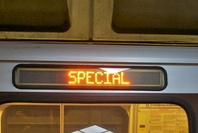Ask GGW: Where are “SPECIAL” Metrorail trains going?

It’s the weekend, and there’s track work taking place on the Metrorail system. Trains are running on reduced headways, and after an extended wait, a train finally rolls in — but the side destination sign says “SPECIAL”. Where’s it going? Should you get on? And why does it seem like the train itself has no particular destination in mind?
“SPECIAL” trains show up most often when there’s track work going on somewhere on the line, but, the fact is, they can appear at any time. To understand how the problematic signs come to be, it’s important to first understand how the side destination signs on Metrorail trains are set.
The train operator doesn’t actually set the destination station, even though this is what riders see from the platform. Rather, he or she sets a destination code, which indicates the train’s destination station and the route it will take. Destination codes are two digits long, so there are only 99 destination codes available. This means that not all possible combinations of stations and routes can be displayed; there are some stations where trains can terminate that don’t have a destination code assigned.
One of these stations is East Falls Church, where all westbound Orange Line trains from downtown terminated this past weekend due to the Dulles Corridor Metrorail Project. Thus, Orange Line trains bound for East Falls Church display “SPECIAL” all the way from New Carrollton to East Falls Church. This work has been going on throughout 2011, and will continue in 2012, based on Metro’s track work schedule.
Because the PIDS (the in-station “next train” display boards) are also driven by trains’ destination codes, more often than not they only display “Train”.
Regardless of the destination code set, the train operator can manually override a train’s side destination signs, forcing them to “SPECIAL” or “NO PASSENGERS” with the use of a switch in the cab. In certain circumstances (especially when there’s no track work going on), it may be the case that the train operator has the right destination code entered but has failed to set the train identity control switch appropriately. In those cases, a kind word on the intercom or through the cab window will often get the problem resolved.
The situation is an accessibility and wayfinding nightmare. While operators of “SPECIAL” trains are supposed to make frequent public address announcements with regard to the train’s route, they’re often inaudible to the majority of passengers, and at their best, they still do nothing for hearing-impaired riders.
Where a station without a destination code is a frequent terminal due to work (like East Falls Church), the best solution would be for WMATA to revise the destination code table plugged into each railcar’s display system. Unfortunately, that requires bringing every railcar into the shop, an expensive and time-consuming proposition.
In the meantime, riders may find it helpful to know that if, for example, there’s track work on the Orange Line, but not the Blue Line, then westbound trains at downtown stations that display “SPECIAL” are almost certainly operating on the Orange Line and terminating at East Falls Church.
Even if Metro can reduce the use of “SPECIAL” destination signs for frequent work, these trains will always exist. Not every station can have a destination code; there simply aren’t enough codes.
Sometimes trains will need to terminate at a certain station due to work very infrequently, and for them it’s probably not worth it to reset the codes for a one-time event. That was the case this past weekend, when Green Line trains from Greenbelt terminated at Georgia Avenue. Their destination signs displayed “SPECIAL” while going southbound, but the switch replacement work on the Green Line at U Street was a one-weekend event.
In any circumstance, since they’re going to continue to exist, Metro should make more of an effort to communicate the route and destination of “SPECIAL” trains to customers.
